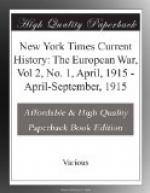The allied powers are agreed that the European resettlement must be inspired by the principle of nationality. It will be but just if Hungary suffers severely from its application, for during the past forty years no European Government has sinned so deeply and persistently against that principle as has her Magyar Government. The old Hungary, whose name and history are surrounded by the glamour of romance, was not the modern “Magyarland.” Its boasted constitutional liberties were, indeed, confined to the nobles, and the “Hungarian people” was composed, in the words of Verboeczy’s Tripartitum Code, of “prelates, barons, and other magnates, also all nobles, but not commoners.” But the nobles of all Hungarian races rallied to the Hungarian banner, proud of the title of civis hungaricus. John Hunyadi, the national hero, was a Rumane; Zrinyi was a Croat, and many another paladin of Hungarian liberty was a non-Magyar. Latin was the common language of the educated. But with the substitution of Magyar for Latin during the nineteenth century, and with the growth of what is called the “Magyar State Idea,” with its accompaniment of Magyar Chauvinism, all positive recognition of the rights and individuality of non-Magyar races gradually vanished.
The Magyar language itself is incapable of expressing the difference between “Hungarian” and “Magyar.” The difference is approximately the same as between “British” and “English.” The “Magyar State” set itself to Magyarize education and every feature of public life. Any protest was treated as “incitement against the Magyar State Idea” and was made punishable by two years’ imprisonment. It was as though a narrow-minded English Administration should set itself to obliterate all traces of Scottish, Welsh, and Irish national feeling; or as though the Government of India should ignore the existence of all save one race and language in our great dependency.
In comparison with the Government of “Magyarland,” the Government of Austria was a model of tolerance. In Austria, Poles and Ruthenes, Czechs, Germans, Italians, Serbo-Croatians, and Slovenes were entitled to the public use of their own languages and enjoyed various degrees of provincial self-government. The Austrian side of every Austro-Hungarian banknote bore an indication of its value in every language of the empire, whereas the Hungarian side was printed in Magyar alone. This was done in order to foster the belief that Hungary was entirely Magyar.
In reality, Hungary is as polyglot as Austria. Exact statistics are not obtainable, since the Magyar census returns have long been deliberately falsified for “Magyar State” reasons. Roughly speaking, it may, however, be said that, in Hungary proper, i.e., exclusive of Croatia-Slavonia, where the population is almost entirely Serbo-Croatian, there are perhaps 8,500,000 Magyars, including nearly 1,000,000 professing and a large number of baptized Jews. Against this total there are more than




